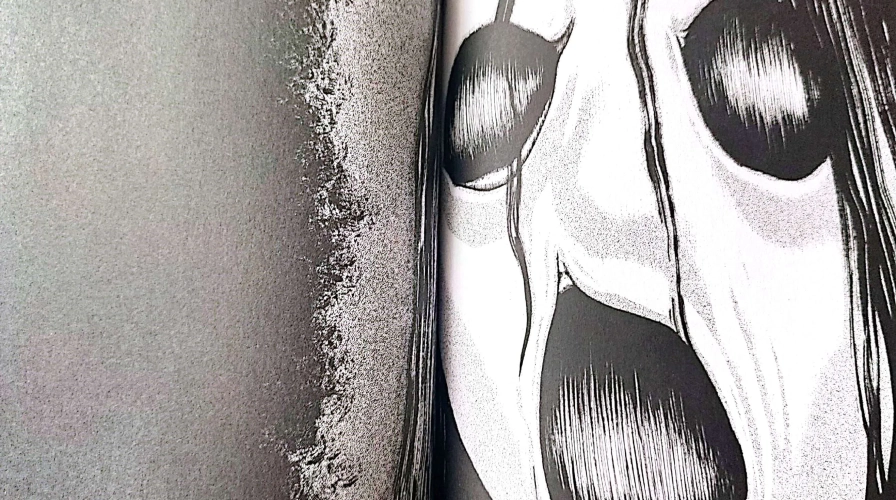"After Junji Ito, discover the new horror manga phenomenon!" This is the tagline used by Mangetsu to introduce PTSD RADIO by Masaaki Nakayama. But what is this new hair-raising horror story worth, which boldly claims to follow in the footsteps of the great master of horror manga?

Horror That Pulls at the Hair...
The most obvious similarity between PTSD RADIO and Junji Ito’s major works (which are also published by Mangetsu) is the presence of hair-based horror, which appears right from the first chapters. Junji Ito often incorporates a disturbing visual horror aesthetic centered around hair. This same theme is found in PTSD RADIO, both visually and as the core of the curse afflicting the various characters.
The first volume opens with a full-page illustration of freshly cut hair scattered across the floor. We then see a little girl in tears as her grandmother cuts her hair extremely short. The grandmother reassures her, saying, "It's the best thing to do for now if you want him to leave you alone." But who is this "him"? That is the main question in this first volume of PTSD RADIO, one that may leave readers puzzled at first—but more on that later.
The eerie hair theme continues with a young woman whose long hair is mysteriously pulled backward by an unknown force. Later, in another timeline, a lock of hair (supposedly from a fallen soldier) is placed in a funeral box by his family. And what about the child who witnesses a strange, thread-like mass swallowing and dragging away his grandfather’s body?

There are few deaths in this volume—this is far from a slasher story—but horror fans will relish the full-page illustrations that amplify the tension at the end of each chapter. In terms of horror storytelling, this first volume of PTSD RADIO will certainly delight fans of the supernatural and eerie suspense. The horror seeps into everyday life, manifesting in different places and time periods.
In this, Masaaki Nakayama is quite generous. The horror creeps up on you in a train, in the corners of an apartment, in the depths of a forest, in a rural village from an older Japan, or in the graffiti-covered hallways of a high school at night. He plays with a variety of settings, each meticulously crafted with a deceptive sense of normalcy. Compared to Junji Ito, Nakayama’s linework is less textured, especially in character design, which is smoother. However, his backgrounds are highly detailed, making the immersion just as effective.
A Plot Hanging by a Thread
While PTSD RADIO excels in horror, its fragmented storyline may leave readers feeling lost. This first volume presents a series of disconnected horror vignettes, almost like a collection of eerie short stories. Readers will need to pay close attention if they want to identify any underlying connections.
However, certain recurring elements suggest an overarching narrative: the mysterious statuette that appears multiple times, seemingly at the heart of the horror, and the ritualized straw doll that comes to life. These repeated motifs indicate that the volume is not just a random sequence of terrifying tales—there is a deeper, hidden thread tying them together. But for now, PTSD RADIO embraces a deliberately "disheveled" structure.

Moreover, the multitude of characters makes it difficult to follow the story as a whole. The character designs are not highly distinctive, making it easy to confuse different individuals. Some characters, like Chifuyu (the young woman whose hair is pulled) and her ex-boyfriend Keita, appear regularly, but many others seem interchangeable. This can cause confusion, especially when the story jumps across different timelines.
The narrative is completely non-linear—if not outright chaotic. While this labyrinthine structure adds to the eerie atmosphere, it might frustrate readers who prefer a more straightforward plot. A second reading could help piece together some clues, but it’s clear that the full picture of this six-volume series will only emerge as more volumes are released.
To fully appreciate this first volume of PTSD RADIO, readers must be willing to embrace its cryptic nature and wait for Volume 2 to potentially connect the scattered threads of the story. The volume leaves us with fragmented glimpses of eerie faces and cryptic poetic phrases at the end of each chapter. With its intense close-ups and unsettling atmosphere, PTSD RADIO hooks the reader while also creating a sense of frustration—like listening to a radio station that keeps switching between clarity and static. This is likely Masaaki Nakayama’s intent, proving himself as a promising new name in the horror manga genre.





Comments (0)